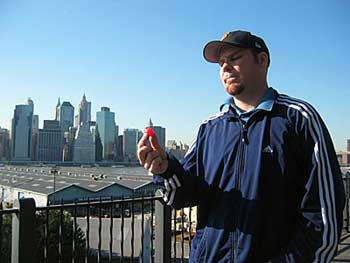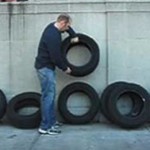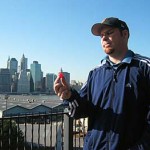A little over a year ago, someone forwarded a URL to me for a website featuring a guy who had challenged Shaquille O'Neill to a free-throw competition. For each free-throw O'Neill made in a game, Lee Walton also made one. On his website he kept score, and I would check back from time to time to see who was winning.
More recently, Lee Walton was featured on ASPECT: A Chronicle Of New Media. Thoroughly amused, and inspired, by his work, I started a conversation with the New York-based artist via email. Our conversation was slightly delayed, due to Lee's becoming a father on July 15th, but here is the full text as Lee talks about humor, Experientialism and his little red ball.
MN: In your bio, you describe yourself as an 'Experientialist', and mention humor as one of your major themes. Can you talk about how you came to create work this way, what it means for you to be an Experientialist, and why humor is a useful tool for a conceptual artist?
LW: After being referred to as a Conceptual Artist, Performance Artist and other terms, I started to get frustrated. The more I learned about these practices, the more I realized that I am not them. For example, I take Sol Lewitt's "Rules on Conceptual Art" very seriously and therefore cannot consider myself a conceptual artist. I have too much respect for those rules.
If I was a painter... I would paint.
As for the term "performance artist", I could never grasp what that exactly that is? I don't think if your in front or behind a camera should determine if you are performing or not. That seems ridiculous. My relationship to my body is not any different than the tip of my pencil. It's just a tool. When you make a drawing, nobody watches the activity of the tip of the pencil and considers that a "performance". Jumping and sliding all around...
The term, "Experientialist" I like.
Its not a matter of comfort, in fact, its about being uncomfortable. Instead of lying in bed and knowing exactly what I am and what I do, now I lay in bed and wonder what the fuck an Experientialist is? Once I accept a title I have a job description. No thanks.
As for humor, I am completely lost to that one. I didn't actually write my bio (if you can write a better one please do...) but the idea of humor as a theme or tool is strange. I think it is just a by-product of the things I do and the way I do them, like a person's particular handwriting.
I can be ridiculously serious about things too.
MN: Your current project involves finding a place to leave your 'Little Red Ball', and asks for audience participation in concluding this project. Can you talk about the origins and progress of the 'Little Red Ball' performances, and why it is time to bring it to an end?
LW: I don't know if it will ever end!
The Red Ball Project started back in 2000 when a very web savvy friend of mine was frustrated with the way people were using the internet to make art. At this time, he felt, "the only internet art happening was being done by people that know how to use the medium- and it was art "about" the medium rather than "using" the medium." He then invented the website "Silent Gallery" and invited me to do a project. He wanted to find out what would happen if an artist that knew nothing about "how" the medium works was given the chance to use it.
My idea was to use the web to connect to people and democratically decide on a particular square inch in San Francisco to place my little Red Ball.
People from all over the world were voting and empathetically relating to my relation to the little Red Ball. It was pretty strange. It was also at a time when online interactive voting along with personal Quick-times wasn't really being done yet, so people really felt attached and responsible for the balls fate. They were happy to see it go on the tip of home plate at Pac Bell Park.
MN: Many of your performances and drawings involve sports in some way. You have challenged Shaquille O'Neill at free-throws, mapped all seven games of the Yankees/Red Sox series, to name a few. These are always funny, complex, and it is clear that you have a strong relationship to sports. What is it that you find so inspiring about sports and competition?
LW: I like the idea that sports, like the arts, are basically an absurd reality made up of rules agreed upon by everybody. For example, consider the chalk end zone line on the football field of the Super Bowl. If the ball inches its way across that line late in the 4th quarter, it could alter the lives of most of the people in the world. From money, parades, pride, heartache, anger - whatever! it just seems funny to me that it is all because of a chalk line and agreed upon rules. Pollack was also agreed upon.
Growing up, sports were my passion. I was actually recruited to play baseball at the college level and did, but it started to seem like work and I enjoyed too many other things (girls, parties, playing music). Babe Ruth could do both...must have been a great life.
As I plunged into the arts, I started to realize the similarities with sports. I always considered "play" to be a very serious thing...I was delighted to find out that there was a group called the "Situationists" that believed the exact same thing!
MN: On the latest ASPECT dvd, you present your piece 'Making Changes', in which you make minor adjustments to places in your neighborhood. How did this project come about? What do you hope to accomplish by confronting the world in such a minor (if funny) way?
LW: On in your dvd, you present (if funny) the latest adjustments to places your piece 'Making Changes', neighborhood ASPECT this project How did What do you hope to in which you make. accomplish by in minor such a minor way? confronting the world come about?
MN: Ok, so I read that last one a few times. What it makes me wonder, though, is how different it is to move words in a question rather than objects on the street. Do they both work the same way for you, and show the small changes you want to affect?
LW: Moving words in a question or objects in the street both have the same meaning for me...or at least the intention is the same. Drawing a line across a piece of paper, taking a bus across the city, moving this coffee cup across my desk (which I just did) is all the same. The only difference is in the qualities of the objects and the space they are in. Each action will render a different affect (to me and or you), but this is secondary to the act. The "affects" of moving the coffee cup across my desk is subtle and difficult to measure or formalize. However, when I walk a 35 pound weight 4 miles across the city, the "affects" are much different and obvious, yet yield no more importance. I just touched my nose.
MN: What can the Big RED audience do to help find a final resting place for the Little Red Ball?
LW: My Little Red Ball has got to go! We have fallen out of love and lately we have just been going the routines of a relationship. This is no way to live our lives. We are living a lie.
I was a fool to fall for the Red Ball from the beginning. I was warned about her love, but did not heed the words of the people who care for me. Now, I am calling upon these same people to help me rid the ball in a way that will ease my guilt and sugar coat this separation.
Help me find a a worthy fate for my Little Red Ball. I only need about 25 more suggestions- so please hurry!
MN: What's in the future for Lee Walton? Do you plan on bringing your work to Boston anytime soon?
LW: My future? I am lost on that one. That is as confusing as my past...
However, looking at my calendar, I can tell you three things I will definitely be doing in 2005.
I will be doing some projects in Boston this year for an upcoming exhibition at Art Interactive. Curated by Christina Ray and hosted by Glowlab, the entire space will be transformed into a working lab conducting artistic and psychogeographic experiments.
Also, I will be visiting Iceland to "Make Changes" for the Reykjavik Art Museum. I don’t have much time to stay, so I will need to start "changing" things as soon as I step of the plane...
On Sunday, August 14th at Noon, I will be doing a somersault on the corner of Walker and Broadway in Manhattan.
- From Lee Walton vs. Shaquille O’Neill.
- Still image from Making Changes.
- Where in Manhatten will Lee part with his little red ball?
Links:
Lee Walton
ASPECT Magazine
Glowlab
Art Interactive
"DEAD KIDS DO NOTHING" curated by artist Adam Stennett, is on view July 7 through August 7, 2005 at 31 Grand in NYC.
All images are courtesy of the artist.






